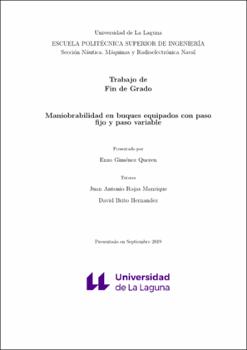Maniobrabilidad en buques equipados con paso fijo y paso variable.
Author
Gimenez Queren, EnzoDate
2021Abstract
El principal objetivo es comprobar si existen diferencias en la capacidad de maniobra de los
buques seg´un el tipo de propulsor que tienen equipado. Para cumplir con este objetivo, se
deben esclarecer previamente determinados conceptos e ideas. El primero de estos conceptos
es el de “maniobrabilidad”, definido como la capacidad de un buque para posicionarse
respecto a su entorno y siempre a voluntad del maniobrista.
Otros conceptos e ideas de relevante importancia en este trabajo son los efectos que producen las h´elices como elementos propulsores de un buque y la reacci´on que cabe esperar de
cualquier buque ante ellos; para as´ı poder aprovechar algunos de esos efectos para maniobrar
con mayor eficacia y sin sobresaltos.
Para este trabajo, se han escogido a dos buques para ser comparados, intentando que
tengan cierta similitud. Los buques son diferentes en cuanto a funcionalidad, no obstante,
sus dimensiones estructurales son muy similares.
Para comparar la capacidad de maniobra de ambos buques, se han consultado las curvas
de evoluci´on de cada uno de ellos. Estas curvas aportan datos acerca de la capacidad de
maniobra de cada buque en particular, normalmente cuando el buque se halla en condici´on
de lastre. Los datos que se ofrecen en estos gr´aficos son obtenidos en las pruebas de mar
con diferentes maniobras, las cuales se explican en este trabajo (al igual que el significado
de los datos que se obtienen de dichas maniobras).
Finalmente, se han alcanzado unas conclusiones acerca de cu´al es el mejor tipo de propulsor
para un buque. The main objective is to test if there’s any difference in the maneuveral capacity of a
vessel according to the type of propeller which they have equipped.To accomplish with this
objective, it must be clarifed previously dterminated concepts and ideas. The first one is
”maneuverability”, definited as the capacity of a vessel for position itself respect to their
environment and alwaysat the helmsman will.
Other concepts and ideas of relevant value in this redacction are the effects produced by
the propellers as propellant elements of a vessel and the reaction that is expected in any
vessel. The veseel can take advantage of this effects for maneuver with effectiveness and
with no frights.
For this redacction, it has been choosen tow vessels for to be compared, triying that they
are some similar. The vessels are different in their work, but their structure is so similar.
In order to compare the maneuveral capacity of both vessels, it have been consulted the
Evolution Curves of each one vessel. This graphics provides data about the maneuveral
capacity of each vessel, normally when the vessel is in ballast condition. The data showed
on this graphics are obtained in the sea testing proves with differents movemments and
maneouverings, which are explained in this redaction (including the meaning of the data
obtained in those maneuoverings).
Finally, some conclusions have been reached about which type of propeller is better for a
vessel.





